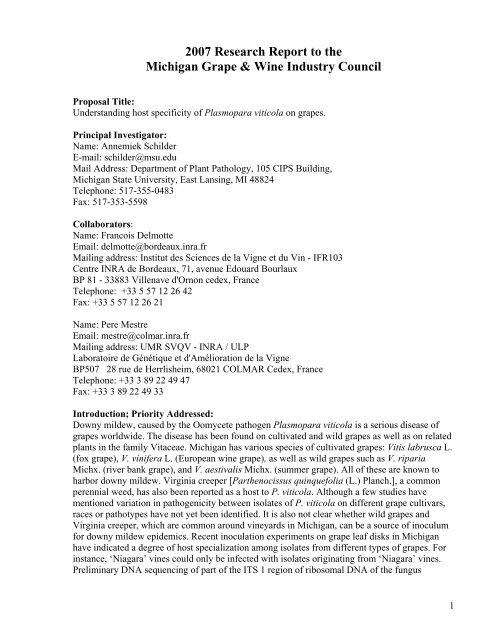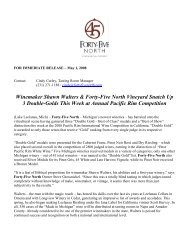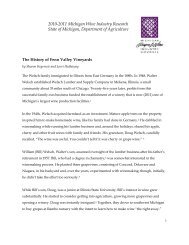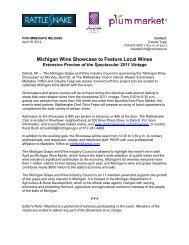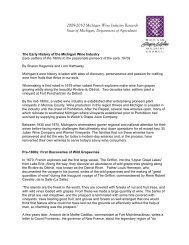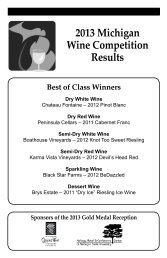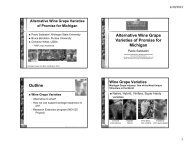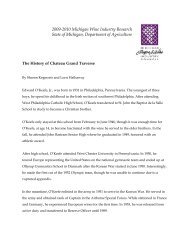Understanding host specificity of Plasmopara ... - Michigan Wines
Understanding host specificity of Plasmopara ... - Michigan Wines
Understanding host specificity of Plasmopara ... - Michigan Wines
Create successful ePaper yourself
Turn your PDF publications into a flip-book with our unique Google optimized e-Paper software.
2007 Research Report to the<strong>Michigan</strong> Grape & Wine Industry CouncilProposal Title:<strong>Understanding</strong> <strong>host</strong> <strong>specificity</strong> <strong>of</strong> <strong>Plasmopara</strong> viticola on grapes.Principal Investigator:Name: Annemiek SchilderE-mail: schilder@msu.eduMail Address: Department <strong>of</strong> Plant Pathology, 105 CIPS Building,<strong>Michigan</strong> State University, East Lansing, MI 48824Telephone: 517-355-0483Fax: 517-353-5598Collaborators:Name: Francois DelmotteEmail: delmotte@bordeaux.inra.frMailing address: Institut des Sciences de la Vigne et du Vin - IFR103Centre INRA de Bordeaux, 71, avenue Edouard BourlauxBP 81 - 33883 Villenave d'Ornon cedex, FranceTelephone: +33 5 57 12 26 42Fax: +33 5 57 12 26 21Name: Pere MestreEmail: mestre@colmar.inra.frMailing address: UMR SVQV - INRA / ULPLaboratoire de Génétique et d'Amélioration de la VigneBP507 28 rue de Herrlisheim, 68021 COLMAR Cedex, FranceTelephone: +33 3 89 22 49 47Fax: +33 3 89 22 49 33Introduction; Priority Addressed:Downy mildew, caused by the Oomycete pathogen <strong>Plasmopara</strong> viticola is a serious disease <strong>of</strong>grapes worldwide. The disease has been found on cultivated and wild grapes as well as on relatedplants in the family Vitaceae. <strong>Michigan</strong> has various species <strong>of</strong> cultivated grapes: Vitis labrusca L.(fox grape), V. vinifera L. (European wine grape), as well as wild grapes such as V. ripariaMichx. (river bank grape), and V. aestivalis Michx. (summer grape). All <strong>of</strong> these are known toharbor downy mildew. Virginia creeper [Parthenocissus quinquefolia (L.) Planch.], a commonperennial weed, has also been reported as a <strong>host</strong> to P. viticola. Although a few studies havementioned variation in pathogenicity between isolates <strong>of</strong> P. viticola on different grape cultivars,races or pathotypes have not yet been identified. It is also not clear whether wild grapes andVirginia creeper, which are common around vineyards in <strong>Michigan</strong>, can be a source <strong>of</strong> inoculumfor downy mildew epidemics. Recent inoculation experiments on grape leaf disks in <strong>Michigan</strong>have indicated a degree <strong>of</strong> <strong>host</strong> specialization among isolates from different types <strong>of</strong> grapes. Forinstance, ‘Niagara’ vines could only be infected with isolates originating from ‘Niagara’ vines.Preliminary DNA sequencing <strong>of</strong> part <strong>of</strong> the ITS 1 region <strong>of</strong> ribosomal DNA <strong>of</strong> the fungus1
Summary <strong>of</strong> the expenditures during the period.Budget category Original Budget ($) Expenditures ($) _Salary 3,840 3,541Fringe 0 420Travel 700 0Materials and supplies 1,000 1,641Other direct costs 350 288Total 5,890 5,890Results and conclusions <strong>of</strong> the project1) Determine genetic diversity among P. viticola isolates from different grape <strong>host</strong>sDNA was successfully isolated from 109 downy mildew samples from <strong>Michigan</strong> and compared toDNA <strong>of</strong> 14 European and two Canadian isolates. DNA sequences were generated by PCR forfour different nuclear genes (28S, ITS, tubulin, actin). Phylogenetic analysis yielded fourdifferent clades (A-D) corresponding to different <strong>host</strong> plant groups. The information obtainedfrom each <strong>of</strong> the four genes was congruent. Figure 2 shows the different groupings <strong>of</strong> the isolatesbased on analysis <strong>of</strong> the 28S gene. Only selected isolates are shown in the tree for space reasons.Clade A contains downy mildew isolates from Vitis riparia (riverbank grape) and Vitis hybrids,such as Chancellor and Vignoles. Clade B contains downy mildew isolates from Vitis labruscaand Vitis eastivalis (summer grape). The European isolates appeared identical and fell into thisclade. Clade C contains isolates from Vitis vinifera and table grapes (Vitis spp.), whereas CladeD was quite distinct and contained isolates from Parthenocissus quinquefolia.AB C DEF G HFigure 1. Downy mildew infection and sporulation on different <strong>host</strong> species used in genetic andmorphology study. A) symptoms on Vitis labrusca ‘Niagara’, B) Vitis aestivalis, C) V. riparia, D)Parthenocissus quinquefolia, and sporulation on E) Vitis labrusca ‘Niagara’, F) Vitis aestivalis,G) V. riparia, and H) Parthenocissus quinquefolia.3
77Likely root <strong>of</strong> the treeU24c Parthenocissus92U25c ParthenocissusMsu60 Sandhill ChancellorMsu71c Sandhill ChancellorMsu52 Trevor RipariaMsu123 Leelanau RipariaMsu104 NW OrtegaU30 Canada Labrusca VitisMsu01c Campus Riparia99Msu137c Sleeping RipariaMsu03 Trevor ChancellorMsu53 Trevor RipariaU39 Canada Labrusca VitisMsu92 Clarksville VignolesMsu04 Trevor ChancellorMsu136c Sleeping RipariaMsu124 Leelanau RipariaClade DMsu100c NW PinotMsu107 Shady Riesling98Msu56 SW TableMsu99 NW PinotMsu106 Shady RieslingClade CMsu16 Trevor NiagaraMsu82 Clarksville NiagaraMsu13 Trevor NiagaraMsu79 Clarksville NiagaraMsu09c Trevor NiagaraMsu10c Trevor Niagara99CUS05 FranceMsu34 Trevor AestivalisMsu83 Clarksville NiagaraALB02 FranceMsu37 Trevor AestivalisClade BClade A0.00128S, p-distance, NJ19 mutations + 1 indelFigure 2. Phylogenetic tree (based on DNA sequence <strong>of</strong> the 28S gene) showing relatedness <strong>of</strong><strong>Plasmopara</strong> viticola isolates collected from various grape and other <strong>host</strong>s in <strong>Michigan</strong>, Canada,and France. Isolates are representative <strong>of</strong> a larger group <strong>of</strong> 109 isolates which are not shown.4
2) Assess morphological diversity among P. viticola isolates from different grape <strong>host</strong>sWhile sporangial size <strong>of</strong> downy mildew isolates supposedly is variable and influenced by thesubstrate the pathogen is growing on, we found that sporangial size differed significantly amongthe genetic groups we identified. Isolates from Virginia creeper (Parthenocissus quinquefolia)were the smallest, while isolates from Clade B (Vitis labrusca and Vitis aestivalis) were smallerthan those <strong>of</strong> Clade A (Vitis riparia and Vitis hybrid isolates) and Clade C (Vitis vinifera and tablegrape isolates). The morphological differences support genetic differences among isolates fromdifferent <strong>host</strong> groups. These data suggest that downy mildew isolates on different <strong>host</strong>s in theVitaceae family are either different species or subspecies. Further studies are needed by downymildew taxonomists to decide this.Average length <strong>of</strong> sporangia (micrometers)Average width <strong>of</strong> sporangia (micrometers)30302525202015151010550A B C DGenetic group (clade)0A B C DGenetic group (clade)Overall conclusionsThis research project has shown that downy mildew populations on cultivated and wild grapes in<strong>Michigan</strong> are not uniform and vary genetically and morphologically. Genetic groups (or clades)are formed according to the <strong>host</strong> that the downy mildew isolates originated from. While extensivesampling was not possible in each clade, e.g., due to limited occurrence <strong>of</strong> downy mildew in<strong>Michigan</strong> Vitis vinifera vineyards, there appear to be four distinct groups: Clade A, whichcontains isolates from Vitis riparia (riverbank grape) and Vitis hybrids; Clade B, which containsisolates from Vitis labrusca and V. aestivalis; Clade C, which contains isolates from Vitis viniferaand table grapes (Vitis sp.), and Clade D, which was quite distinct and contained isolates fromParthenocissus quinquefolia. Past pathogenicity tests support the hypothesis that there arebiological limitations to cross infection, such that genetically separate downy mildew populationscan co-exist in the same location. It appears likely that wild V. riparia may serve as a source <strong>of</strong>inoculum for hybrid grapes, but not for V. labrusca juice grapes. Downy mildew on Virginiacreeper is a separate population that is restricted to Virginia creeper. The research has alsoyielded information regarding European isolates, which cluster with isolates from Vitis labrusca.This raises an interesting question on the origin <strong>of</strong> these isolates, which heret<strong>of</strong>ore were thoughtto have been introduced into Europe with V. rupestris rootstocks in the mid 1800’s. This meritsfuther investigation.5
Communications Activities, Accomplishments, and Impacts:The impact <strong>of</strong> this study is a better understanding <strong>of</strong> the biology and population structure <strong>of</strong><strong>Plasmopara</strong> viticola on grapes. This may lead to better methods <strong>of</strong> managing the disease, forinstance, by treating downy mildew on juice grapes and wine grapes as two separate pathogenpopulations that may have biological differences as well. In addition, the study showed thatgrapevine breeding programs need to consider using mixtures <strong>of</strong> isolates from different Vitis <strong>host</strong>sto properly screen for downy mildew resistance in grapevine breeding lines. However, most <strong>of</strong>the impact will be in the longer term, as research collaborations have been established with theNational Agricultural Research Institute (INRA) in France. The goals <strong>of</strong> the INRA programs areto develop wine grape varieties with durable resistance to downy mildew as well as to understandthe origin <strong>of</strong> downy mildew introductions into Europe. Future plans are to screen hybrid grapelines for downy mildew resistance at MSU using <strong>Michigan</strong> P. viticola isolates due to the limiteddiversity <strong>of</strong> downy mildew populations in Europe. These lines may become available forsustainable wine grape production in the future. In addition, genetic testing for a mutationconferring fungicide resistance in downy mildew isolates from <strong>Michigan</strong> maybe conducted by theINRA labs in the future. Future goals <strong>of</strong> the MSU-INRA team include a survey <strong>of</strong> downy mildewisolates throughout the East Coast <strong>of</strong> the USA to pinpoint the potential source <strong>of</strong> the European P.viticola isolates. The research results will be presented at upcoming grape extension and scientificmeetings. In addition, submission <strong>of</strong> a publication to a scientific journal (e.g., Phytopathology) isplanned for the fall <strong>of</strong> 2008.Funding Partnerships:An application to the Viticulture Consortium East for additional funding was not granted in 2007due to elimination <strong>of</strong> the Viticulture Consortium funds that year. However, MGWIC funding wassupplemented by funding from INRA France, which conducted the DNA extraction and geneticanalyses (valued at more than $10,000).6


